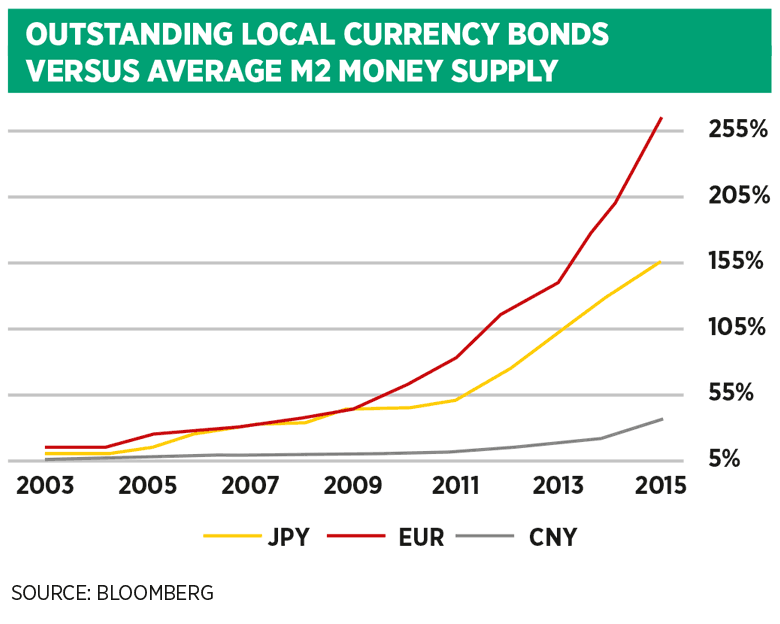
Everyone is talking about panda bonds (or renminbi-denominated bonds issued by international issuers), even when investor confidence in both China’s growth story and the renminbi’s value seem to be waning, albeit not unanimously.
We, on the other hand, think panda bonds are on their way to becoming international bonds similar to G3 bonds, not because of the Chinese economy, but because the Chinese regulators will likely make this happen. However, many challenges remain. The first and foremost would be evolving regulations for the panda bond market.
It seems unlikely that the People’s Bank of China (PBOC) will drastically devalue the renminbi. Instead, the bank will defend its currency value using its FX reserves to buy renminbi or perhaps adjusting its policies to stem capital flights.
These flights could be slowed by expanding the panda bond market, a move that would boost onshore liquidity. Panda bond development may well come at the expense of offshore renminbi-bond markets or so-called dim sum bonds.
According to Bloomberg, panda bond issuance has risen to RMB 21bn (at the time of writing) from RMB 2bn at the end of 2014. And yet the size of the panda bond market was only 0.04% of the total onshore renminbi bonds (also known as Chinese yuan (CNY) bonds and worth RMB 47 trillion). The closest local currency bond market is the Japanese local currency bond market, including Japanese yen (JPY) or samurai bonds issued outside Japan.
Samurai bonds accounted for 2.5% of all outstanding JPY bonds. We plotted local currency outstanding bonds in Japan, the eurozone and China against their respective M2 money supplies (see the table below) and found that CNY bonds have a long way to go before they reach 100% of China’s M2 money supply. We expect the share held by panda bonds in total outstanding CNY bonds to rise towards 2.5% in the near future from the current 0.04%.
The International Finance Corporation (IFC) has predicted that panda bonds outstanding would exceed $50bn by 2020. We think the CNY bond market could grow in the same way as the JPY bond market did in 2006. It took Japan four to five years from 2006 to grow its domestic bond market from a third of the size of the country’s M2 money supply to the 50% mark.

Assuming that outstanding CNY bonds will account for 50% of China’s M2 money supply ($21.5 trillion) in China by 2020 (the same as their level in 2015, a conservative estimate) and 2.5% of these will be the panda bond share of total outstanding CNY bonds, so the outstanding panda bonds could rise to $268bn by 2020.
RMB 364.3bn and RMB 175.6bn of dim sum bonds will mature in 2016 and 2017, respectively, according to Bloomberg. If Chinese regulators continue to allow these issuers to use panda bond proceeds outside China, declining onshore yields and rising onshore liquidity will motivate issuers to sell panda bonds to refinance their dim sum bonds.
Issuers of dollar bonds may even consider selling panda bonds to diversify their investor bases and reduce currency risk.
Panda bond proceeds usually cannot be taken outside of China. We believe that this rule stalled the growth of the panda bond market in the past
Panda bond development will also help expand the CNY bond market and, unintentionally, cannibalise the dim sum bond market. About 95% of CNY bond investors are Chinese accounts, and a loss of foreign investor confidence in the Chinese economy will not affect demand for CNY bonds so much as that for dim sum bonds (of which most investors are foreign accounts).
It is true that panda bonds can be issued by any entities outside China, as long as they are approved by Chinese regulators. For non-Chinese issuers, we expect panda bonds to be issued by investment-grade issuers, specifically sovereigns, quasi-sovereigns, provincial governments, and high-quality financial institutions and corporates.
For Chinese issuers incorporated outside China, we believe that the panda bond new issuer list will be similar to that of regular CNY and/or dim sum bonds. In other words, the panda bonds issued by these entities will be a mixed bag of investment- and non-investment-grade credits.
We said the Chinese regulators will jump-start the panda bond market. Now let’s look at how the regulators could amend the current panda bond rules to accomplish just that.
We believe that this rule stalled the growth of the panda bond market in the past. The IFC launched the first-ever panda bonds back in 2005. Since then, only IFC, Asian Development Bank and Daimler have issued, until last year, when some panda bond issuers received exemptions to repatriate proceeds outside China.
We expect the exemptions to become an official rule for two reasons. First, the ability to repatriate proceeds is perhaps the main reason many issuers are interested in issuing panda bonds. Second, the Chinese government’s determination to expand the panda bond market will encourage PBOC to relax this rule.
International investors and issuers may not be familiar with Chinese rating agencies, and their lack of a relationship with them may prolong the underwriting period and deter international issuers altogether. However, many issuers, such as Daimler and Canada’s British Columbia province, have received exemptions on the Chinese credit rating requirement.
Which could be difficult for international issuers and underwriters to understand. Daimler has been allowed to simply explain the difference in its IFRS-based and CAS-based figures without having to re-release its financial statements under CAS. We understand that PBOC has, to some extent, acknowledged the validity of the IFRS, but has not offered much of an opinion on Japanese and US accounting standards.
This could mean that US and Japanese issuers are less likely than their European counterparts to issue panda bonds. Moreover, the existing rule requires three years of financial results, with management discussion in Chinese for all panda bond issuers. Translation or conversion of foreign accounting standards into CAS takes time and could slow down panda bond development.
In short, exemptions from the accounting standard are not clearly explained and this is an area where the PBOC could clarify the rules so that corporate treasurers can plan their renminbi financing.
Foreign investors accounted for only about 2% of outstanding CNY bonds at the end of 2015, according to Reuters. The PBOC announced last July that sovereign wealth funds, supranational institutions and central banks would no longer need pre-approval to invest in China’s interbank bond market.
In our view, this will increase demand for good-quality investment-grade corporate and quasi-sovereign panda bonds due to limited risk appetite of these institutions. The inclusion of renminbi in the IMF’s special drawing rights means that central banks will increase renminbi-denominated assets, including panda bonds.
As in, those listed on the exchanges, rather than issued via the interbank market. We understand that the former merely requires approval from the China Securities Regulatory Commission (CSRC) and preregistration with an exchange.
Private placements do not have as many requirements, such as the 40% maximum debt limit (of net assets) for additional CNY bond issuance. In addition, these private-placement panda bonds do not require Chinese credit ratings.
These exchange-traded panda bonds will be less liquid than those traded in an interbank market, which is far bigger in size. This could mean that issuers of such exchange-traded bonds will pay higher coupons than for panda bonds listed in the interbank market.
However, looser supervision and regulations could mean that exchange-traded panda bonds would be much quicker to issue and, as a result, would immediately benefit from existing onshore liquidity.
The speed of panda bond development depends on how efficiently the Chinese regulators move, in our view. The time for panda bonds is now and it could not be more necessary (for the Chinese regulators) than ever to push panda bonds to become a prominent global fixed-income product.
Warut Promboon is chief rating officer at Dagong Global Credit Rating Ltd in Hong Kong
